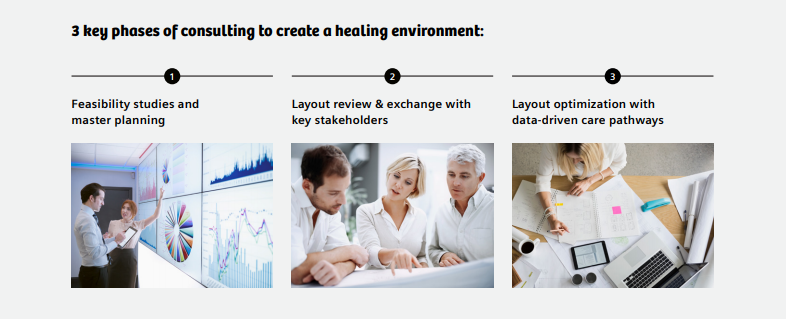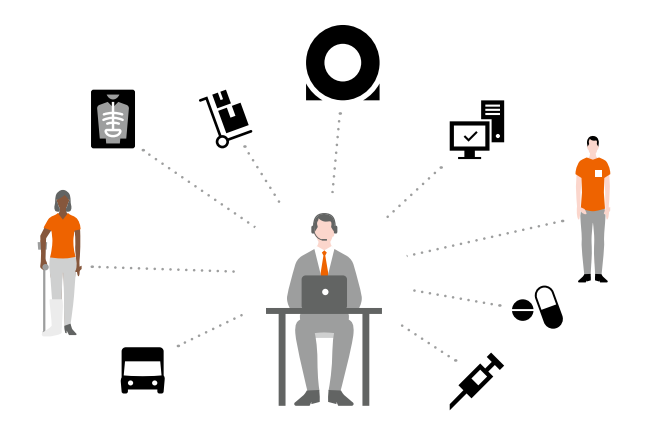The human-centered approach to healthcare facility
planning and design.











Executive Summary
Transforming care delivery through facility design and planning
Healthcare environments continue to evolve, with new pressures from patients, staff, and payers
driving care providers to be more people-centered and value-driven. Meeting the challenges of
today’s healthcare markets require a re-examination of the way care facilities are planned, designed,
built, and operated.
Digital technologies are a significant solution to enable optimization of proposed as well as
existing facilities. Simulations, including VR simulations, can offer end-users and planning and
design staff a realistic view of the conceptual design, enabling them to optimize the efficiency and
satisfaction of both patients and staff before committing to “real world” action. These tools are part
of a larger shift toward digitalizing healthcare, which will enable data-based decision-making on
both clinical and non-clinical issues.
Designing and operating a modern healthcare facility require the collaboration of planners and
designers, medical technology partners, and hospital staff. In addition, clinical departments
should come together around care pathways, rather than departmental fault lines, in order to
deliver the best possible quality of care and experience for all involved.
Medical technology partners are uniquely qualified to guide healthcare institutions through the
lifecycle of their care facilities with consultants whose expertise and experience are enhanced
by leadership in medtech innovation and are especially well qualified to provide a fact-based
strategic perspective and deep implementation know-how.
Market-shaping healthcare trends
Hospitals have always measured the quality of the
care they provide in terms of safety and effectiveness.
While those measures of quality are still critical, today’s
healthcare providers must engage with additional forces
shaping the market.
Value-based care, which ties performance ratings and,
in some cases, reimbursement, to patients’ assessments
of the overall quality of care they receive, is on the rise
in many Western markets. Patient experience factors are
a key determinant of the quality of care in value-based
care regimes.
At the same time, there has been a trend toward
consumerization of healthcare. Patients have more choice
in their healthcare and more input into their treatment
plans. Delivering a high-value care experience is of
primary importance to healthcare provider organizations,
because patients can and will seek alternatives if they are
not satisfied.
According to Isabel Nieto Alvarez, Global Marketing Manager
for Improving Patient Experience at Siemens Healthineers,
patient experience should be divided into two segments.
One is the clinical outcome that can be measured and
quantified directly. The other is the experience. It is very
possible to have a good clinical outcome, but a poor
experience: “The clinician tells you the treatment worked,
but you still feel poorly, so you’re not satisfied, and you
don’t report a positive experience overall,” she explains.

Rising consumerism in healthcare is not limited to the
industrialized nations of Europe and North America; the
middle class is growing around the world, paced by rapid growth in economic output in countries in the Asia
Pacific region.1 This rise in middle class status brings
new expectations and demands for more patient-centric
care models and more positive care experiences
around the world.
Consumerism in healthcare also manifests itself in
increased travel for care that is not available or is more
expensive in the patient’s home country.2
This can provide a significant revenue stream to a
healthcare organization. Making an institution attractive
and competitive in this market requires dedication to
delivering a positive and culturally appropriate experience
for both patients and their traveling companions.
Finally, staff satisfaction is of paramount importance to
provider organizations. There are more positions on care
teams than there are qualified candidates, so competition
for employees can be very intense. Minimizing turnover is
vital to delivering a good care experience. Keeping staff
happy and engaged goes beyond direct compensation;
facility planning and design can play an important role in
delivering a good experience to care teams, non-clinical
staff, and patients.4

- Design healthcare facilities around
patients’ holistic needs
Patient-centered design is a departure from the design
principles that dominated hospital construction from
the mid-20th century onward. At that time, efficiency
of construction, heating and cooling, and clinician
workflow mandated spaces that often seemed cold
and “clinical.”5
This emphasis on narrowly defined measures of efficiency
has been reappraised in the last decade or two, as substantial
evidence of the importance of patient experience factors
into the healing process has emerged. The physical design
of a facility can have a powerful effect in creating a
healing environment in which patients can recover more
quickly from injury or illness. For example, a comparison
of length of hospital stay for patients with beds near
a window compared with those whose beds were near
a door showed that the “window” patients were in the
hospital an average of 0.43 days less than the comparator
group.6 A single-center study published in 2005 found
that, following spinal surgery, patients who were exposed
to more natural sunlight felt less stress, reported less
pain, and used less analgesic medication compared with
patients who stayed on the “dim” side of the hospital.7
The right design of the room and medical devices play an
important role in influencing the patient’s emotional
experience. Before the examination patients’ feelings can
fluctuate between insecurity, anxiety – and hope. Room
Create a healing environment
and product designs geared toward these extreme
emotional situations can serve as a distraction, give joy,
and offer a sense of security.
Biophilic design brings the natural world into the hospital
through spaces such as gardens, courtyards, plants, and
also items/materials such as glass partitions that have
leaf/grass/flower motifs inherent within. Alleviating the
environmental stress a patient is under is part of the
healing experience. The objective is to make the hospital
health oriented, not disease oriented, for patients, staff,
and the communities they serve. Recent studies suggest
that biophilic design can help speed recovery, decrease
analgesic use, and reduce stress.8,9
And that situation, in the era of value-based care, can
have significant repercussions. Some payers directly
incentivize positive measures of patient experience; but
even in the absence of a direct financial link, a reputation
for great patient experience is a competitive advantage.
Thus, improving patient experience is in the best interest
of every healthcare institution.
Thoughtful design of a healthcare facility can also
improve staff satisfaction, resulting in more empathetic,
more effective care. Natural light, effective ventilation,
and a quiet environment can help clinicians achieve
their best performance. Key patient experience factors,
like communication with the care team and coordination
of care, have a direct positive correlation with the
effectiveness and safety of care.10
Clearly, hospital design that facilitates effective
communication among staff, healthy collaboration among
departments, and respectful, private communications
between staff and patients pays dividends. Patients
have better health outcomes, and this leads to better
overall experiences. Other important factors are
increased satisfaction, more engagement, and lower
turnover for employees in healthcare facilities. Only
then can healthcare providers be positioned to thrive
in a competitive, value-based environment.

2. Make a commitment to “go green”
Hospitals leave a large footprint on the environment,
which can contribute additional health stressors for
people. Many organizations are actively seeking to
mitigate these environmental factors. Klinikum
Forchheim in Bavaria, Germany is one such institution.
Designed to admit ample natural light, the hospital also
uses a state-of-the-art system known as a Thermally
Activated Building Structure (TABS) to reduce heating
and cooling costs by taking advantage of temperature
gradients between the external environment and the
building to provide heat in winter and cooling in warmer
weather. Use of TABS and other technologies has
enabled the hospital to reduce its environmental
footprint substantially.

3. Build partnerships that center around
patients’ needs
As previously described, it is imperative to build healthcare
facilities centered around patients and the care pathways
they will travel, rather than traditional departmental
structures or rigid processes. The mission of healthcare
facility planning and design professionals is to create a
healing environment that optimizes each patient’s
experience, while also supporting the care team. To
achieve this mission, effective healthcare facility planning
requires a robust and dynamic partnership among patients,
clinicians, architects, medtech firms, and consultants in
order to create a facility that is up to the challenges of
both today and tomorrow.

Examples of patient-centered themes
A multisensory approach to the patient in-room
experience is part of the vision of Siemens Healthineers.
In order to achieve a holistic in-room experience, the
goal is to integrate various elements: sound and aroma,
sculptures, ambient room light, a smart storage system,
ergonomic patient positioning aids, and a pleasant
in-bore experience. Together, these features will create a
unique and positive atmosphere.
The images below show a collection currently of four
different themes that fit into the look and feel of the
company’s products. The themes are all available as
static and moving images in high quality and can be
applied to the products, walls, or storage items as
stickers or projections. A special focus was placed on
designing themes that keep the distraction for the
medical staff to a minimum.
Underwater
This theme speaks particularly to patients suffering from
pain and anxiety as well as children. The bright and
fascinating underwater world awakens feelings of being
on vacation and suggests a wonderful weightlessness.

Beach
The “Beach” theme is suitable, above all, for
claustrophobic patients with its ability to reduce stress
and contribute to sustainable relaxation. As the eyes
wander over the beach: feelings of warmth, freedom,
and relaxation come to mind.

Flowers
Patients often feel exposed and vulnerable. With its
cheerful and naturally positive energy, the “Flowers”
theme is suitable for conveying security and harmony as
well as blossoming vitality to such patients.

Jungle
The lovingly designed colorful theme doesn’t just make
little patients happy – it also offers several highlights for
patients of all ages to discover. This theme creates an
atmosphere of wonderment, fascination, and joy.

Key roles for medtech partners
As healthcare has grown more complex, medtech
companies have taken on expanded roles beyond their
original remit of manufacturing, installing, and servicing
medtech hardware. The key competencies that today’s
medtech partners can bring to bear in healthcare facilities
planning and design are described below.
Consulting
Putting patients first is more than just a change in mindset;
it is a change in the way healthcare facilities are designed,
built, and operated. This change goes beyond the clinical
to encompass social and cultural factors as well.
In order to meet the complex challenges of creating a
healing environment, medtech consulting teams bring a
formidable combination of planning, implementation, and
operational capabilities to the table for their partners.
Medtech consultants play important roles throughout the
process, from initial feasibility studies and master planning
through implementation and ongoing operation and
optimization. Dr. Karl-Philipp Kienle, Senior Management
Consultant, Siemens Healthineers, describes the roles that consulting plays in planning, designing, and operating
healthcare facilities: “Up front, we offer strategic
transformational consulting, where we look at the business
case, make demand projections, assess competitors, and all
the things you need to do in order to plan your project.
Then, we help create data-driven care pathways and
perform process and layout optimization so that the facility
will be up to the challenges of today and tomorrow.”

Planning and visualization
Building modern healthcare facilities around the patients
they will serve and the care teams that will work there
requires extensive research and planning. But even the most
sophisticated clinicians may not grasp the implications of a
layout when viewed in flat technical renderings.
That’s where 3D and 4D simulation tools come into play.
These digital tools (such as SitePlanner, developed by
Siemens Healthineers) can rapidly create a prototype
layout for a new facility, from a single imaging or OR
suite to an entire hospital wing, without ever breaking
ground. In addition, VR capabilities help end-users of the
facility to experience what it’s like to be on the floor and
adjust the layout of the space to meet their needs in a
more powerful and direct way than architectural
drawings permit.
These simulation tools can also help optimize non-clinical
spaces and workflows. “Let’s look at the whole reception
process for new patients in a hospital. Now, we can
enable patients to do part of the registration at home.
The whole workflow at the reception area can be
streamlined. And this has a strong impact design and
patient experience,” said Michael Schmitz, Head of
Facility Design & Planning Services, Siemens Healthineers.
Transforming healthcare delivery
with digital optimization tools
The creation of a high-fidelity “digital twin” of a facility
enables healthcare providers to test changes to processes
and/or layout without costly rearrangement of the actual
physical space. The fidelity of such workflow simulations is
increased by the addition of multiple robust data sources,
including RTLS (real-time location systems) data from
various assets and entities. The predictive capabilities of
workflow simulation makes it a powerful tool for rapidly
validating layouts and workflows.
Digital tools for workflow simulation also help hospital
administrators create an environment that optimizes
efficiency as well as patient and staff satisfaction. For
example, simulations can help designers strike the right
balance between patient privacy needs and utilization
rates of capital equipment like MRI scanners by informing
decisions on the placement and number of patient
dressing rooms and prep areas.
RTLS (real-time location systems) can track the status
and location of medical equipment, and can also help
patients find their way around large and often confusing
hospitals. Coupled with clear and intuitive physical
wayfinding signage, RTLS can demystify the hospital
experience and get patients through the physical
environment quickly and safely. RTLS sensors can also
detect potential falls or other potential problems more
quickly. In terms of planning and optimization, RTLS
technology can be leveraged to provide data for a highfidelity model of processes, enabling optimization with
tools like workflow simulation.

Partnership in action:
Helse Stavanger
University Hospital
The customer
Helse Stavanger HF is a university hospital in Stavanger,
a city of 130,000 in southwestern Norway. The hospital
is in the midst of a significant expansion, with the
construction of a new building expected to be completed
in 2023. The staff of Helse Stavanger HF strives to provide
the best possible care and treatment to their patients every
day. The new construction is an important step toward
their goal of becoming the best hospital in Norway, and a
benchmark for other hospitals.
About Helse Stavanger HF
- Located in the city of Stavanger, Norway
- Mission: To provide the best possible care and treatment to their patients – every single day
- University hospital with radiology and interventional & nuclear medicine department
- Staff of 7,500 drawn from 30 nationalities
- 600 beds
- Serves a population of 369,000 in Stavanger and the surrounding area
Conclusion
The hospital of the future: An integrated enterprise
Until recently, an architectural firm would design the
physical space, after which medical technology vendors
would supply the equipment needed to make the facility
operational. The accelerating pace of development in
medical and other technologies has rendered that
paradigm obsolete. What’s needed today is tight
coordination throughout the project between architects,
medical technology partners, end-users, and
administrators.
“As architects, our design can only be as good as the data
we receive. Working with the people who will use this
facility, and with a partner like Siemens Healthineers,
who has deep insight into both the technology and the
clinical aspects of modern healthcare, is a huge
advantage,” according to Henning Lensch, CEO, RRP
International Hospital Planners.
The challenge these days is to also ensure that the facility
is sustainable and delivers a positive experience to both
patients and staff. “The staff must be happy in order to
do their jobs well,” Lensch added.
Innovation and teamwork are central to the
Siemens Healthineers offerings in facility planning and
design. The company and has extended its capabilities
beyond clinical equipment and departments like surgery,
imaging, and diagnostic labs. Today consulting teams can
help administrators assess, plan, implement, and optimize
the performance of disparate departments and functions
adjacent to those core areas by leveraging the operational
experience and insights garnered over the years and
combining them with innovative technology. Giving the
Siemens Healthineers consulting team a seat at the table
during the earliest stages of planning ensures that their
expertise delivers the greatest benefit to the patients and
staff who will use a new healthcare facility.
Partner with Siemens Healthineers to transform care delivery
Siemens Healthineers is more than a leading medical
technology provider; we are also a trusted partner in
facility planning and design. The company has a track
record of working with cross-functional teams to develop
innovative care facilities and healing environments.
Partner with Siemens Healthineers to develop your
hospital of the future.
References
1 Kharas H. The emerging middle class in developing countries.
Brookings Institution, June 2011.
2 Ruggeri K, Záliš L, et al. Evidence on global medical travel. Bulletin of the
World Health Organization. 2015; 93:785-789. Accessed 25 February at
https://www.who.int/bulletin/volumes/93/11/14-146027/en/.
3 Development of the Middle Class 2020–2030
https://www.brookings.edu/blog/future-development/2018/09/27/
a-global-tipping-point-half-the-world-is-now-middle-class-or-wealthier/
4 Yamaguchi Y. Better healing from better hospital design. Harvard Business
Review. 5 October 2015. Accessed 25 February 2020 at
https://hbr.org/2015/10/better-healing-from-better-hospital-design.
5 Kisacky J. When fresh air went out of fashion at hospitals.
Smithsonian Magazine. 14 June 2017. Accessed 25 February 2020 at
https://www.smithsonianmag.com/history/when-fresh-air-went-outfashion-hospitals-180963710/
6 Park MY, Chai C-G, et al. The Effects of Natural Daylight on Length
of Hospital Stay. Environ Health Insights. 2016;12:1-7.
7 Walch JM, Rabin BS, et al. The effect of sunlight on postoperative analgesic
medication use: a prospective study of patients undergoing spinal surgery.
Psychosom Med. 2005;67:156-63.
8 Wynhorst N. Biophilic design in health care. Hospital and Healthcare.
29 January 2019. Accessed 25 February 2020 at
https://www.hospitalhealth.com.au/content/design-in-health/article/biophilicdesign-in-health-care-1494624725#ixzz6E9v7KhNq.
9 Kazmierczak L. Nature’s cure: using biophilic design to enhance healing.
Accessed 25 February 2020 at https://www.nacarchitecture.com/naclab/
naturescure.aspx.
10 Doyle C, Lennox L, Bell D. A systematic review of evidence on the links
between patient experience and clinical safety and effectiveness.
BMJ Open. 2013;3:e001570. doi:10.1136/bmjopen-2012-001570.
Accessed 25 February 2020.
Latest Articles
Decision Support, clinical decision support, Siemens Healthineers, CDSS, health care quality, medical error, Computer-Based Clinical Decision Support System, Healing Environment of the Future
How to Create the Healing Environment of the Future

























